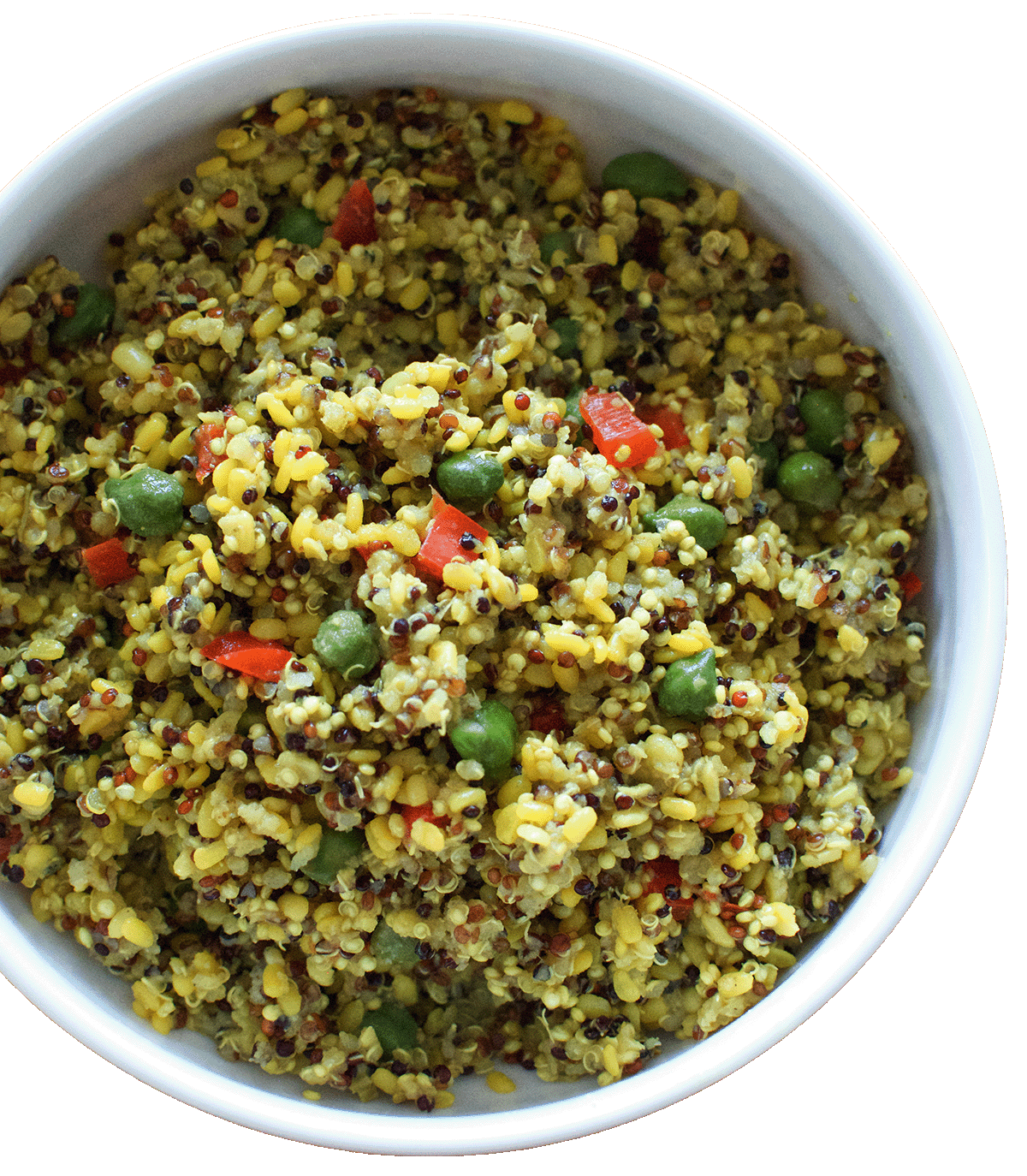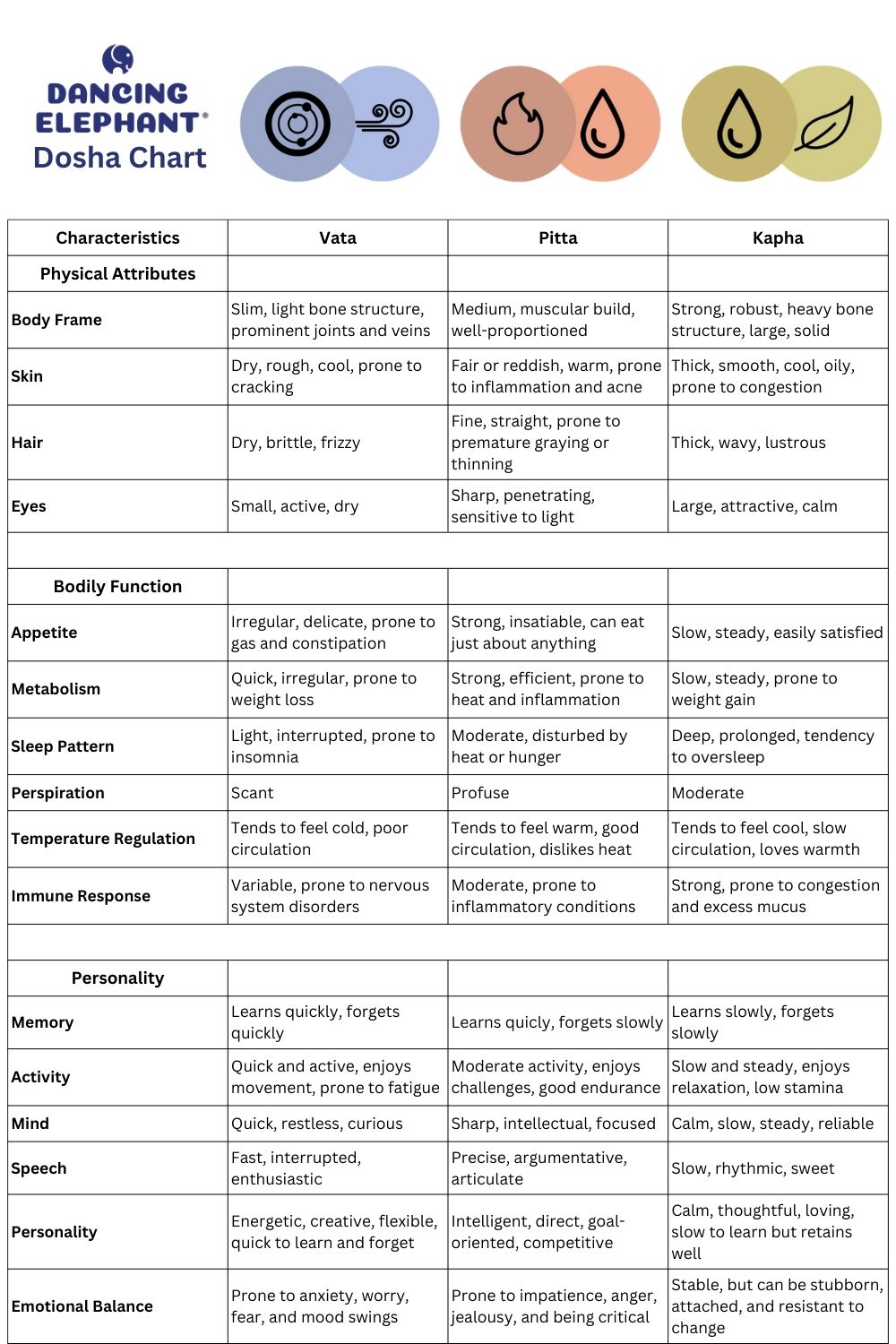Delving Deeper into Ayurveda: Ancient Wisdom, Not a New Health Trend
The ancient lifestyle philosophy of Ayurveda may seem daunting and complicated. Ayurveda is not a new food or health trend. It is thousands of years worth of thought, therapy and wisdom for optimum health that connects the mind, body and spirit. We at the Dancing Elephant have been practicing everyday ayurveda for generations though we are not ayurvedic practitioners. We consulted Ayurvedic experts trained in the US and India and created our company to synthesize the knowledge and wisdom into bite size pieces that can be translated into the everyday life of our community and applied into actionable, healthier living.
Through the ancient wisdom of Ayurveda, the Dancing Elephant seeks to provide easily accessible healthy food options that allow our community to sustain a balanced lifestyle in a busy, modern world.

Ayurveda Fundamentals
Here is a bit of what we understand in case you want to dig deeper. Science says we are all made of stardust, elements of the universe and nature. Essentially, we all have within us a unique balance of space, air, fire, water and earth (See below). This fundamental concept/belief is the basis of ayurvedic philosophy.
If we each understand the proportions of these elements in our constitution, then we can also figure out how change on the outside affects us on the inside. This delicate balancing dance connecting the inside and the outside within an evolving biological, emotional and spiritual ecosystem is meant to guide us to a state of harmony. When we take time to reflect on what we eat, our mental health, relationships, the seasons and all the other variables within and around us, we have each begun the journey of finding balance. In a nutshell, this is the path of ayurveda.
The 3 Doshas
Ayurveda classifies the elements that we are composed of into three general categories: Vata (predominantly ether and air); Pitta (predominantly fire and water); Kapha (predominantly water and earth). Each dosha has its combinations of qualities just like the elements they embody. One is not better than the other. We are made up of a varied combination of two or all three doshas rather than fitting neatly into one category and this unique combination can change through time. Each one of us is just unique and has to find our own journey to balance and wellness through each phase of life.
Vata (Air and Ether)
Vata is the energy of movement and governs bodily functions related to motion, such as the circulation of blood, respiration, and nerve impulses. It is characterized by lightness, dryness, coolness, and changeability. When in balance, Vata promotes creativity, mental clarity, and vitality, while an imbalanced Vata can result in anxiety, ungroundedness, and various physical ailments.
Pitta (Fire and Water)
Pitta is the energy of metabolism and transformation. It governs functions related to digestion, absorption, and body temperature regulation. Pitta is characterized by heat, sharpness, and intensity. Balanced Pitta gives rise to intelligence, courage, and strong digestion, whereas an imbalanced Pitta can lead to anger, jealousy, and inflammatory conditions.
Kapha (Earth and Water)
Kapha is the energy of structure and stability. It governs functions that provide physical form, such as the formation of cells, tissues, and the proper lubrication of joints. Kapha is characterized by heaviness, coldness, and stability. When in balance, Kapha fosters love, patience, and a strong immune system, while an imbalanced Kapha can lead to lethargy, weight gain, and attachment issues.
To balance your doshas, you intuitively use an antidote that counters the lack or excess quality that is present. For example, you instinctively rub some cream or oil on dry skin or wear more layers to keep warm when you feel cold.
By understanding your Dosha, it allows you to feed your need and find your balance, just like a Dancing Elephant. Here is a table to help you understand the varying Characteristics of each Dosha or take our quiz to find out your alignment.
Ayurvedic Diet and Nutrition
In Ayurveda, food is not just sustenance, but a form of medicine, and diet is a crucial component in maintaining health and balance. Ayurveda identifies six tastes - sweet, sour, salty, bitter, pungent, and astringent. Each taste corresponds to the five elements and has a unique impact on the doshas. Understanding these relationships can guide dietary choices to balance one's unique dosha combination.
One food that embodies the Ayurvedic principles of balance is Kitchari, a nourishing and simple dish made from rice and lentils. Dancing Elephant's Kitchari is a perfect example of a tridoshic meal, meaning it's beneficial for all dosha types. The combination of ingredients in Kitchari makes it a complete protein, providing all the essential amino acids your body needs. It's also easy to digest, making it a soothing choice for those looking to give their digestive system a break.
Dancing Elephant offers a range of Kitchari Premixes that make it easy to incorporate this balanced meal into your daily diet. These premixes are a convenient way to enjoy the benefits of Kitchari, whether you're new to Ayurveda or a long-time practitioner.
Mindful eating is another key aspect of Ayurvedic nutrition. This includes eating in a calm environment, chewing food thoroughly, and eating only when hungry. By incorporating these principles and integrating balanced meals like Kitchari into your diet, you can align your eating habits with the wisdom of Ayurveda.
Ayurvedic Lifestyle Practices
Ayurveda emphasizes the importance of regular routines to maintain health and balance. These routines, known as dinacharya (daily routines) and ritucharya (seasonal routines), are designed to align our bodies with the natural rhythms of the day and the seasons.
Dinacharya (Daily Routines)
- Waking Up Early: Ayurveda recommends waking up during the "Brahma muhurta," which is about 1.5 hours before sunrise. This time is considered auspicious and is believed to be conducive to meditation and spiritual practices.
- Hygiene Practices: This includes brushing teeth, scraping the tongue to remove toxins, and bathing. These practices help to maintain physical cleanliness and purity.
- Yoga and Meditation: Practicing yoga helps to keep the body flexible, strong, and balanced. Meditation helps to calm the mind, reduce stress, and promote mental clarity. Both practices are considered essential for maintaining health and balance in Ayurveda.
- Pranayama (Breathing Exercises): Pranayama exercises help to balance the energy in the body and calm the mind.
- Eating Regular Meals: Ayurveda recommends eating three balanced meals a day, with lunch being the largest meal when the digestive fire (agni) is at its peak.
- Going to Bed Early: Ideally, one should go to bed by 10 PM to ensure adequate rest and rejuvenation.
Ritucharya (Seasonal Routines)
Ritucharya involves adjusting one's lifestyle and diet according to the changing seasons to maintain balance and health.
- Spring: This is a time for detoxification and light, easily digestible foods to counteract the heaviness of Kapha accumulated during winter.
- Summer: The focus is on staying cool and hydrated. Pitta-balancing foods, like sweet fruits and cooling herbs, are recommended.
- Autumn: This is a time of transition and it's important to keep Vata in balance. Warm, grounding foods are beneficial.
- Winter: This is a time to nourish and build strength. Heavier foods and warming spices are recommended to balance the cold, dry qualities of Vata.
Regular exercise that's appropriate for your dosha type is also encouraged. For instance, calming exercises like yoga and walking are good for Vata types, while more vigorous exercises may be beneficial for Kapha types.
Remember, these routines are general guidelines and may need to be adjusted based on your individual constitution, current health status, and local climate.
Ayurvedic Herbs and Treatments
Ayurveda uses a variety of herbs and natural substances for healing and balancing the doshas. Some commonly used Ayurvedic herbs include turmeric, ashwagandha, triphala, and tulsi.
Panchakarma is a traditional Ayurvedic detoxification and rejuvenation process. It includes five procedures that cleanse the body of toxins and restore balance.
Ayurveda and Modern Science
While Ayurveda is an ancient system of medicine, many of its principles align with modern scientific understanding of health and wellness. For example, the Ayurvedic emphasis on a balanced diet, regular exercise, and stress management is supported by contemporary health research. Current research is also exploring the potential health benefits of Ayurvedic herbs and treatments.
Here are some research papers that discuss the benefits of Ayurveda:
- Indian Systems Of Medicine: A Brief Profile by B Ravishankar and Vijay K. Shukla: This paper discusses the importance of medicinal plants in traditional systems of medicine, particularly in developing countries. It provides a comprehensive overview of Indian Systems of Medicine, including Ayurveda, Siddha, and Unani. The paper emphasizes the importance of understanding the conceptual basis of these systems to fully appreciate their benefits and how they function. PDF
- CAM Modalities Can Stimulate Advances in Theoretical Biology by Alex Hankey: This paper argues that complementary and alternative medicine (CAM) modalities, including Ayurveda, can stimulate new approaches to biological regulation. The author suggests that these CAM approaches may be scientifically advanced compared to current Western biology and could lead to a major paradigm shift in both biology and medicine. PDF
- From Exotic Spice to Modern Drug? by Seema Singh: This paper discusses the global demand for more affordable therapeutics and the increasing interest in Eastern traditional medicines, including Ayurveda. The paper highlights the therapeutic potential of curcumin, a staple of traditional Indian medicine, for treating diseases such as cancer and Alzheimer's disease.
- Earthworms Dilong: Ancient, Inexpensive, Noncontroversial Models May Help Clarify Approaches to Integrated Medicine Emphasizing Neuroimmune Systems by Edwin L. Cooper et al.: This paper discusses the potential health benefits of earthworms, which have been used in Ayurveda and other traditional medicine systems. The authors suggest that earthworms could be used as inexpensive, noncontroversial models to help clarify approaches to integrated medicine, particularly those emphasizing neuroimmune systems. PDF
Resources for Further Learning
For those interested in learning more about Ayurveda, there are many resources available. Here are some books that are considered good entry points for learning about Ayurveda:
- Ayurveda: The Science of Self Healing by Dr. Vasant Lad: This book is a practical and philosophical guide to Ayurveda, providing detailed instructions for treatments and recipes.
- The Chopra Centre: Herbal Handbook by Deepak Chopra & David Simon: This book provides a useful guide to herbs and their healing properties according to Ayurveda.
- Ayurveda for Dummies by Angela Hope-Murray: This book provides a comprehensive introduction to Ayurveda, including its history, philosophy, and practical applications.
- The Book of Ayurveda: A Holistic Approach to Health and Longevity by Judith H. Morrison: This book offers a comprehensive introduction to the Ayurvedic way of life, diet, and body types.
- The Complete Book of Ayurvedic Home Remedies by Vasant Lad: This book provides practical and easy-to-follow advice on how to incorporate Ayurvedic principles into your daily life.
- Ayurveda Beginner's Guide: Essential Ayurvedic Principles and Practices to Balance and Heal Naturally by Susan Weis-Bohlen: This book provides a practical guide to Ayurvedic dietary and lifestyle changes that can improve your health and wellbeing.
- Ayurveda and the Mind: The Healing of Consciousness by Dr. David Frawley: This book explores the psychological aspect of Ayurveda, providing insights into how to harmonize the mind, body, and soul.
Please note that the links provided will take you to Amazon for more details about each book. Disclaimer, while Ayurveda has been practiced for centuries, there's limited scientific evidence to support the effectiveness of dosha-based health practices. It's always a good idea to consult with a healthcare provider or an Ayurvedic practitioner before making significant changes to your lifestyle or diet.








